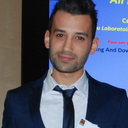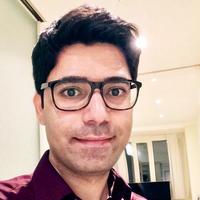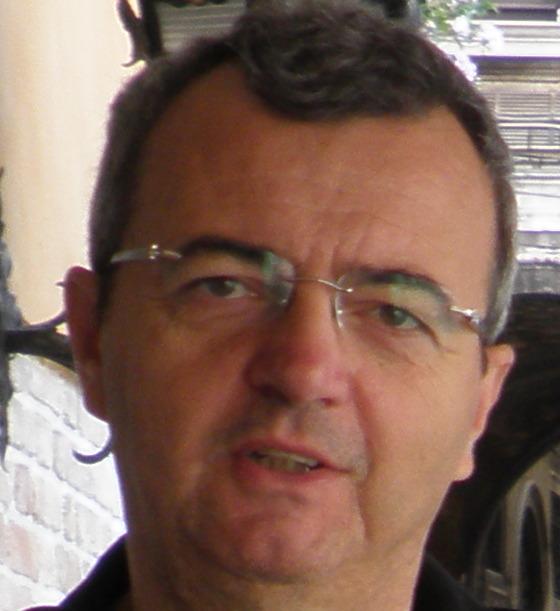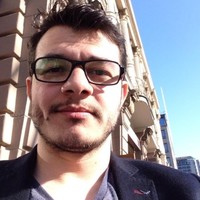
"Online Monitoring of Power Transformer through Measurement of Partial Discharge" by Keyvan Firuzi
Date: March 26
Bio: Keyvan Firuzi received the B.Sc. degree in Electrical and Electronics Engineering from University of Tabriz, Tabriz, Iran in 2012, the M.Sc. degree in Electrical Power Engineering and the Ph.D. degree in Electric Power Engineering (High Voltage Engineering) from Sharif University of Technology, Tehran, Iran in 2014 and 2019 respectively. He was a post-doctoral researcher at the same university from 2019 to 2020. From 2015 to 2018, he was a Research Scientist with Niroo Research Institution (NRI). In 2021, he joined the Electrical and Electronics Engineering Department at METU, where he is currently working as an Assistant Professor.
His research interests include High Voltage Engineering, Dielectrics and Insulation, Partial Discharge, Condition Monitoring and Diagnosis of High Voltage Equipment, Signal Processing, and Machine Learning.
Abstract: Power transformers are a key component of the power network. Online monitoring of power transformers plays an important role in its condition-based maintenance, increases its reliability, availability, and useful service life. Online monitoring facilitates: continuous operation service, early detection of problems, minimize the unpredictable interruption of service, improve plant economy and reliability, and through remedial action the life expectancy of the equipment can be increased.
One of the major failure mechanisms in transformers is partial discharge (PD). PD is regarded as one of the main reasons that lead to the deterioration of oil-paper insulation used in transformers. The main challenge for online monitoring of power transformers through PD measurement is noises coming from different sources. The new method for dealing with noises and also separating and identifying different PD sources using simultaneous measurement of PD with IEC 60270 and Radio Frequency (RF) methods will be presented.

Toward a Semantics Empowered Communication Paradigm by Ali Maatouk
Date: April 2
Bio: Ali Maatouk obtained his M.Sc. and Ph.D. degrees in Electrical Engineering from CentraleSupélec, Gif-sur-Yvette, France, in 2017 and 2020. In 2018, 2019, and 2020, he was a visiting Ph.D. student at the University of Maryland, College Park. He is the recipient of the Labex Digicosme scholarship for academic excellence in 2016. He is also the recipient of both the regional and national André Blanc-Lapierre awards for best master’s student in France in the domain of electricity, information technology, and communication. He was also awarded the 2020 Plateau de Saclay Ph.D. award for his thesis. He is currently a post-doctoral researcher at CentraleSupélec, Gif-sur-Yvette, France. His research interests include massive MIMO systems, NOMA, the Age of Information, and the new notion of data semantics.
Abstract: In the last decade, technological advances in the areas of sensors and wireless communications have led to the emergence of a variety of new applications. Among these applications' diverse functionalities, we cite monitoring, tracking, and even controlling operations in the physical world. These applications' primary objective is to keep a monitor informed and updated on the source's observed physical process. To quantify this notion of timeliness, the Age of Information (AoI) was proposed. The AoI measures the information time-lag at the monitor side, and accordingly, its minimization is regarded as a means to achieve the freshness of information. This talk discusses the main fundamental characteristics of this metric and highlights how it compares to the standard optimization frameworks: delay minimization and throughput maximization. Additionally, a critical view of the traditional communication paradigm is presented. Specifically, while traditional communications overlook the semantics of the data, i.e., the purpose of the use of the data, future communication schemes should be conceived and optimized by taking into account these semantics. For the applications mentioned above, a quantitative and concrete example for semantics is information freshness. For various other applications, a new semantics-based metric is proposed, and its advantages in real-life applications are highlighted.

"Continuous Authentication Security Games" by Serkan Sarıtaş
Date: April 9
Bio: Serkan Sarıtaş is a Postdoctoral Researcher jointly at the Division of Decision and Control Systems, the Division of Network and Systems Engineering, and the Division of Information Science and Engineering, KTH Royal Institute of Technology since September 2018. He received his B.Sc. degree in Electrical and Electronics Engineering, M.S. degree in Computer Engineering and a Ph.D. degree in Electrical and Electronics Engineering from Bilkent University, Turkey, in 2010, 2013, and 2018, respectively. He has been a visiting research student at the Department of Mathematics and Statistics at Queen’s University in Kingston, Canada for five months in 2015. He received the 2020 IEEE Turkey Doctoral Thesis Award. His main research interests include information security, cyber-physical systems, networked control systems, game theory, communication systems, and information theory.
Abstract: Conventional single- and multi-factor authentication are insufficient for preventing sophisticated identity theft attacks, such as account takeover attacks and session hijacking attacks. These attacks may cause catastrophic losses for companies and individuals, and possibly disasters for critical infrastructures. As an extension to traditional identity and access management (IAM) strategies, continuous authentication schemes are increasingly utilized for mitigating such attacks. In the case of continuous authentication, the user’s identity is verified by her behavioral characteristics (i.e., behavioral patterns that are unique to each user) repeatedly or continuously, instead of identifying users with their credentials only once, as in the classical approaches. In the first part, we consider a system operator (defender) that maintains a corporate network (e.g., a critical infrastructure operator), an employee of the organization that uses resources on the corporate network, and an attacker. The interaction between the system operator (defender) who maintains continuous authentication and an intrusion detection system (IDS) in its system consisting of single/multiple resource(s), and the adversarial attacker who tries to execute a rogue command on the system's resources is modeled as a dynamic discrete stochastic game with imperfect information. For this general model, various scenarios are investigated, including the cases of single and multiple resources, a risk-averse and a risk-seeking defender, and the impact of parameter uncertainty. Despite its prominence in identification and its effectiveness in reducing security risks, the results show that continuous authentication only is not enough to secure the system; the additional solutions, such as IDS, are essential for optimal security risk minimization. In the second part, we consider the security of carrier frequency offset (CFO) based continuous physical layer authentication. The interaction between an attacker and a defender is modeled as a dynamic discrete leader-follower game with imperfect information. In the considered model, a legitimate user (Alice) communicates with the defender/operator (Bob) and is authorized by her CFO continuously. The attacker (Eve), by listening/eavesdropping the communication between Alice and Bob, tries to learn the CFO characteristics of Alice and aims to inject malicious packets to Bob by impersonating Alice. By showing that the optimal strategy is a threshold policy, an optimization problem of the attacker with exponentially growing action space is reduced to a tractable integer optimization problem with a single parameter, and then the corresponding defender cost is derived. The results show the importance of the parameters while finding the balance between system security and efficiency.
Keywords: continuous authentication, adversarial learning, dynamic game, Markov decision process, binary hypothesis testing, channel authentication, carrier frequency offset.

"Value of Information in Feedback Control" by Touraj Soleymani
Date: April 16
Bio: Touraj Soleymani is a research fellow at the Division of Decision and Control Systems, Royal Institute of Technology. He received his Ph.D. degree in Electrical and Computer Engineering from the Technical University of Munich in 2019, and his B.S. and M.S. degrees both in Aeronautical Engineering from Sharif University of Technology in 2008 and 2011 respectively. He was a research scholar at the Division of Decision and Control Systems, Royal Institute of Technology from 2017 to 2019, and a research scholar at the Artificial Intelligence Institute, University of Brussels from 2012 to 2014.
His research interests include communication and control in networked environments, distributed control and optimization, and swarm intelligence.
Abstract: In this talk, we present a theoretical framework based on a cost- benefit analysis for networked control systems, and show how the value of information, as the difference between the benefit and cost of a message, emerges from this analysis. To that end, we make a trade-off defined between two objective functions, one penalizing the packet rate and one the state deviation and control effort, in the context of a partially-observable controlled Gauss-Markov process where the sensor is connected to the actuator over a communication channel. This rate-regulation trade-off naturally leads to the adoption of a scheduler at the encoder and of a controller at the decoder as the distributed decision makers, and is formulated as a stochastic optimization problem over the space of causal decision policies. Our main objective is then to characterize an optimal policy profile in the above rate-regulation trade-off.

"Non-Terrestrial Networks in beyond 5G" by Beatriz Soret
Date: April 30
Bio: Beatriz Soret received the M.Sc. and Ph.D. degree in Telecommunications from the Universidad de Malaga (Spain), in 2002 and 2010, respectively. She is currently an associate professor at the Department of Electronic Systems, Aalborg University (Denmark). Before, she has been with Nokia Bell-Labs and GomSpace. She has co-authored more than 70 publications in journals and conference proceedings, with a Best Paper Award in IEEE Globecom 2013. She holds 16 patents in the area of wireless communications. Her research interests are within satellite communications with LEO constellations, low-latency communications and Age of Information, IoT connectivity, and 5G and post-5G systems.
Abstract: The next frontier towards truly ubiquitous connectivity is the integration of Non-Terrestrial Networks (NTN) into 5G networks and beyond. Specifically, the use of Low Earth Orbits (LEO) together with the small satellite technology is a game changer that opens new innovation opportunities while posing major challenges to the design and performance of the communication network. This talk provides a comprehensive overview of NTN, with special focus on LEO constellations, and its essential architectural and technological components.

"Multicast Communications with Varying Bandwidth Constraints" by Mordo Shalom
Date: May 7
Abstract: To find a maximum number of communication requests that can be satisfied concurrently, is a fundamental network scheduling problem. In this work, we investigate the problem of finding a maximum number of multicast requests that can be scheduled simultaneously in a tree network in which the edges and links have heterogeneous bandwidth limitations.
This problem generalizes two problems studied in the literature: maximum k-colorable subgraph in chordal graphs, maximum multi-commodity flow in trees. The problem is NP Hard and admits a 1.585- approximation in the special case of homogeneous bandwidth limitations.
We first show that the problem is harder to approximate when the bandwidth limitations are heterogeneous, i.e., vary from link to link and from node to node. We then generalize a classical algorithm to obtain an M-approximation where M is the maximum number of leaves of the communication subtrees. Surprisingly, variants of the same algorithm, are used in the literature at least four times to solve related problems. There exists a polynomial-time algorithm for the special case of unicast requests and star topology. We generalize this result and relax the second requirement so that the set of unicast requests share a common vertex with no restriction on the tree topology. (Joint work with Yuval Emek, Shay Kutten and Shmuel Zaks - Technion,Haifa)

"Application of High-Temperature Superconducting (HTS) Equipment in Power System" by Ahmad Moradnouri
Date: May 21
Bio: Ahmad Moradnouri was born in Chaloos, Iran in 1991. He received the B.Sc. degree in electrical engineering from Babol Noshirvani University of Technology, Babol, Iran in 2013. He received the M.Sc. and Ph.D. degrees in electrical engineering from Sharif University of Technology, Tehran, Iran, in 2015 and 2019, respectively. Currently he is a lecturer in Sharif University of Technology, Tehran, Iran. His research interests include Application of superconductivity in power system, power transformers, high voltage, electrical insulation and electrical machines.
Abstract: High-temperature superconducting (HTS) power equipment is very promising for the development of future power grids. Advances in R&D and production technology of HTS tapes, zero resistivity characteristics in superconducting state, capacity in the transport of high current density, and characteristics in the transition from superconducting state to normal state and vice versa have opened the way for the introduction of effective equipment, such as HTS transformers, HTS fault-current limiters, HTS cables, HTS electrical machines, and HTS magnetic energy storage systems, to the power grids. In this presentation, application of HTS technology in power system will be investigated.

"Transforming Mobile Imaging Industry with Deep Learning" by Çağlar Aytekin
Date: May 28
Bio: Caglar Aytekin received his B.Sc. and M.Sc. degrees from Middle East Technical University, Electrical and Electronics Engineering department in 2008 and 2011 respectively. He received his Ph.D. from University of Tampere, Signal Processing Department in 2016. From 2016 to 2019, he worked in Nokia as a senior scientist. In 2019, he joined AAC Technologies, where he is currently working as AI team leader. He has over 40 publications and around 30 patents. He won ICPR 2014, IBM best paper award and 3 best Ph.D. thesis awards separately given by city of Tampere, University of Tampere and Scandinavian Conference on Image Analysis council.
His research and business interests include Deep Learning and application of Deep Learning in Imaging, Computer Vision and Pattern Recognition.
Abstract: Deep Learning had significant impact on a wide variety of problems across many disciplines. The development in the field and the related hardware technology enables deploying Deep Learning models on many edge devices. Mobile Imaging is one of the fields that would largely benefit from these advances. The AI team at AAC Technologies, research, develop and deploy modern Deep Learning models for Mobile Imaging. In this talk, the related problems and AAC’s solutions will be briefly presented. Moreover, a specific method on image denoising will be presented in detail.

"Integrated Optical Components for Photonic On-Chip Networks" by Serdar Kocaman
Date: June 4
Bio: Serdar Kocaman is a faculty member in the Department of Electrical and Electronics Engineering at the Middle East Technical University. He received his Ph.D., MPhil, and M.S. degrees in Electrical Engineering from Columbia University and B.Sc. degrees in Electrical Engineering and Physics from Bogazici University.
Abstract: Integrated photonic applications are exciting for extending conventional optical information processing to strengthen key functionalities and offering brand new disrupting technologies. Substantial progress in the literature has already been achieved in scaling down the components and co-integrating various devices utilizing a variety of different material platforms. However, essential improvements are still necessary to realize miniature, low-cost systems in sensing, spectroscopy, communication, and quantum information processing. In this talk, I will briefly discuss infrared imaging systems with higher operating temperature and multi-color functionalities, on-chip switches/modulators for integrated optic applications, and hybrid photonic systems with silicon photonic devices integrated with III-V active components.
